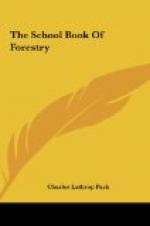[Illustration: What some kinds of timber cutting do to A forest]
It will never be possible to stop timber cutting entirely in this country, nor would it be desirable to do so. The demands for building material, fuel, wood pulp and the like are too great to permit of such a condition. The Nation would suffer if all forest cutting was suspended. There is a vital need, however, of perpetuating our remaining forests. Wasteful lumbering practices should be stopped. Only trees that are ready for harvest should be felled. They should be cut under conditions which will protect the best interests and production of the timberlands. As a class, our lumbermen are no more selfish or greedy than men in many other branches of business. They have worked under peculiar conditions in the United States. Our population was small as compared with our vast forest resources. Conditions imposed in France and Germany, where the population is so dense that more conservative systems of lumbering are generally practiced, were not always applicable in this country. Furthermore, our lumbermen have known little about scientific forestry. This science is comparatively new in America. All our forestry schools are still in the early stages of their development. As lumbermen learn more about the value of modern forestry they gradually are coming to practice its principles.
The early lumbermen often made mistakes in estimating the timber yields of the forests. They also neglected to provide for the future production of the woodlands after the virgin timber was removed. Those who followed in their steps have learned by these errors what mistakes to avoid. Our lumbermen lead the world in skill and ingenuity. They have worked out most efficient methods of felling and logging the trees. Many foreign countries have long practiced forestry and lumbering, yet their lumbermen cannot compete with the Americans when it comes to a matter of ingenuity in the woods. American woods and methods of logging are peculiar. They would no more fit under European forest conditions than would foreign systems be suitable in this country. American lumbermen are slowly coming to devise and follow a combination method which includes all the good points of foreign forestry revised to apply to our conditions.




